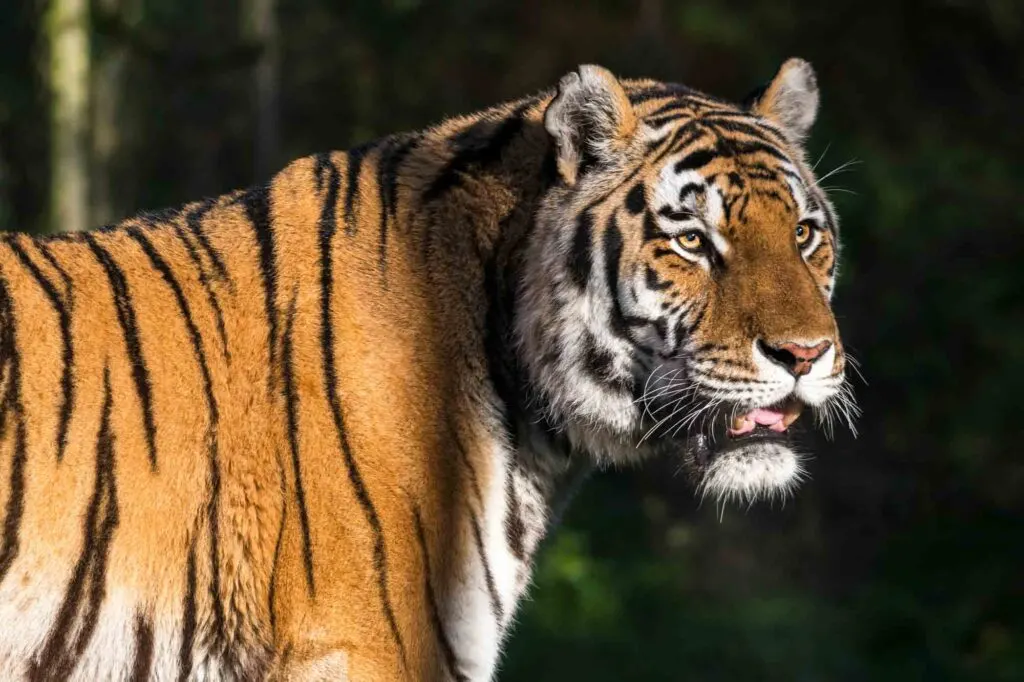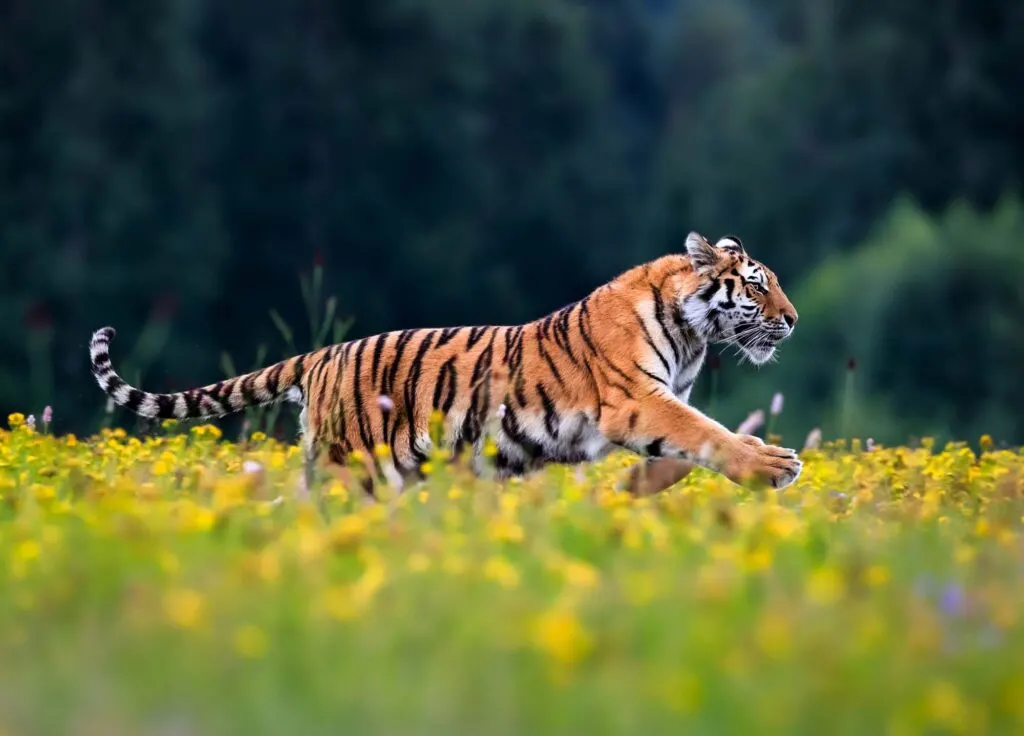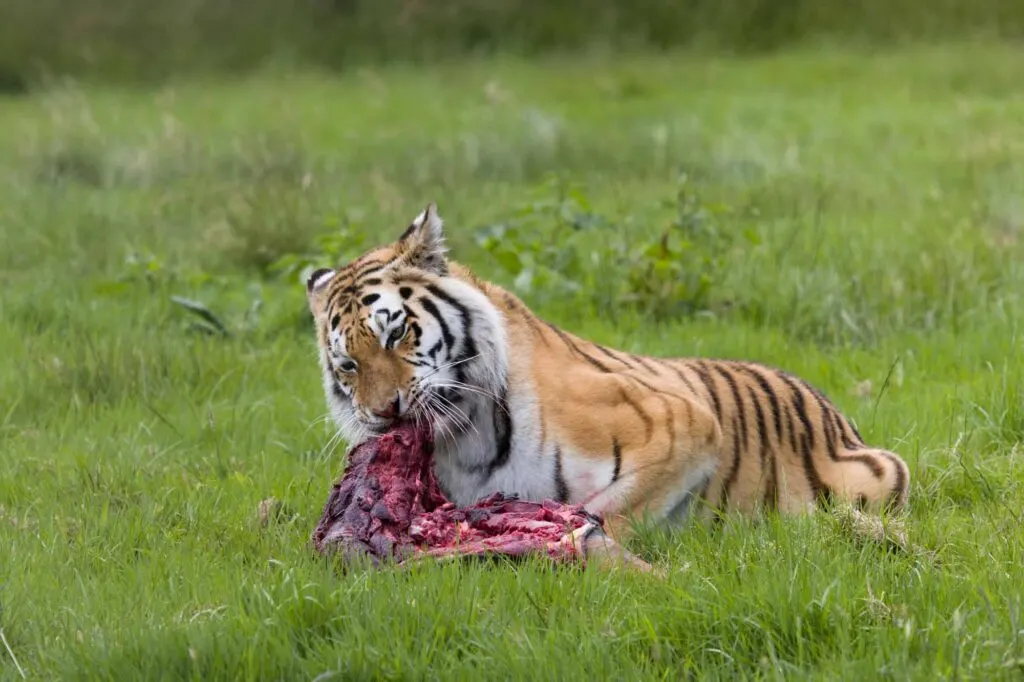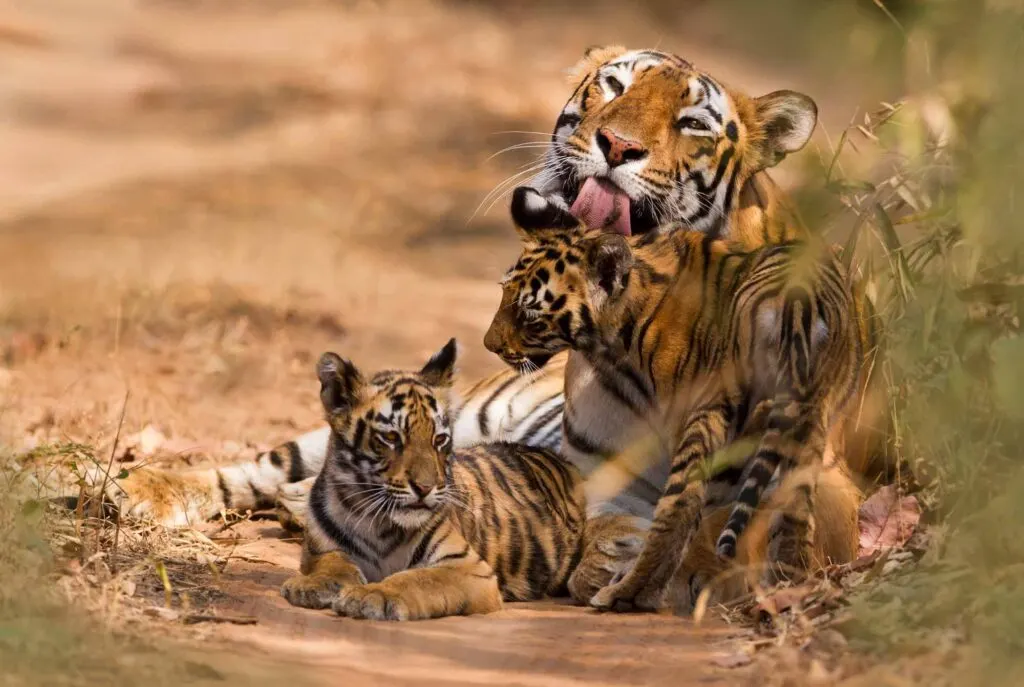As the largest big cat, the tiger is a solitary creature at the very top of the food chain.

Tiger
Panthera Tigris
Tiger Scientific Classification
- Kingdom: Animalia
- Phylum: Chordata
- Class: Mammalia
- Order: Carnivora
- Family: Felidae
- Genus: Panthera
- Species: Panthera tigris
Tiger Appearance

- Lifespan: 8-10 years
- Length: 79-154 inches
- Height: 27.5-47.2 inches at shoulder
- Weight: 140-660 pounds
- Top speed: 40 mph
Tigers are the largest wild cats in the world. Their heavy coats are reddish to orange with vertical black stripes. The black stripes, running on their shoulders and flanks, have different sizes, spacing, and lengths.
These stripes are unique to each tiger and can be compared to a humans’ fingerprint. Some tigers have paler coats, and some are almost entirely white with dark brown or black stripes. The muzzle, underbelly, chest, and throat are lighter in color.
A stretch of white fur extends from above the eyes to the cheeks. A white spot is present behind the ears. A tiger’s tail can be 3 feet long and is usually a darker reddish-orange ringed with many black bands.
Tigers can measure from 79 to 154 inches long and weigh anywhere between 140 to 660 pounds. Imagine a tiger being as long as a full-sized bed and weighing half as much as a grand piano! Tigers have teeth that are 4 inches long and claws as big as house keys.
Currently, only two tiger subspecies are recognized: Panthera tigris tigris comprising the Bengal, Malayan, Indochinese, South Chinese, Siberian, and Caspian tiger populations, and Panthera tigris sondaica comprising the Javan tiger, Bali, and Sumatran tiger populations.
Did you know? The tiger and the snow leopard family diverged from the other Panthera species, meaning they are more closely related to each other than to the lion, leopard, and jaguar.
Tiger Range & Habitat

These Asian wild cats were once widespread across the continent. They could be found from eastern Turkey to the Sea of Japan and from South China across Southeast Asia to the Indonesian islands of Sumatra, Java, and Bali.
Currently, the declining population of tigers exists mainly in the Indian subcontinent, the Indochinese Peninsula, Sumatra, and the Russian Far East. Only 11 of the former 76 tiger range countries still have this animal’s population.
On top of that, individual tigers have a large territory, and the size is determined mostly by the availability of prey.
Tigers live in temperate and tropical biomes, preferring moist tropical rainforests. They can be seen in tropical lowland evergreen forests, dry thorn forests, monsoonal forests, birch and scrub oak woodlands, mangrove swamps, and tall grass jungles.
Distribution
- Continents: Asia
- Countries: Bangladesh; Bhutan; China; India; Indonesia; Laos; Malaysia; Myanmar; Nepal; Russian Federation; Thailand
Habitats
Forest | Shrubland | Grassland
Tiger Behavior and Lifestyle

Tigers are solitary animals preferring to roam alone on their territories most of the time. They are active during the night when their prey moves freely but can be diurnal, too.
Like many other predators at the top of the food chain, tigers are highly territorial, marking their land with scratches on the trees, spraying urine and gland secretions, and clawing at the ground. They primarily stay on the soil but can climb trees, too.
Tigers are strong swimmers and can cross rivers up to 4.3 miles wide and swim about 18 miles a day. They often wash off in ponds, lakes, and rivers.
Tiger Diet

Tigers are carnivores. They mainly feed on the meat of medium-sized animals like sambar deer, water buffalo, wild pigs, wapiti, barasingha, wild boar, and antelopes.
Sometimes they will hunt smaller prey like sloth bears, monkeys, hares, peafowls, other ground-based birds, and fish. Tigers will also pursue other predators like bears, leopards, pythons, and crocodiles.
When in close proximity to humans, tigers will also sometimes prey on such domestic livestock as cattle, horses, dogs, and donkeys. Wild tigers avoid contact with humans, only attacking in reaction to a conflict, when startled, or to protect their young ones.
Man-eating tigers appeared occasionally in the 1970s in India. These tigers were old, without teeth, and couldn’t capture their natural prey anymore.
Tigers, like most big cats, typically ambush their prey. They hunt alone, observing and tracking their game, waiting for the right moment to jump and ambush them. They overpower the struggling target, using their body size and strength to throw the prey off balance.
A successful hunt for tigers usually means leaping onto its quarry, knocking the prey down, grabbing their throats, or nape by their teeth- all at the same time.
Despite being the largest big cats, tigers can run at 30 to 40 mph to chase down their prey, but only in short bursts. So, tigers will stealthily inch closer to their prey before leaping into a run. If the prey senses its predator, the tiger will generally abandon its potential kill rather than chase it down.
While gunning for larger animals, tigers hold onto their prey using powerful forelimbs and bite their throats. Their teeth remain latched onto the necks until the animal dies from strangulation.
In the case of smaller animals, tigers will bite their napes, breaking the spinal cords, piercing the windpipes, or severing the jugular vein.
Tiger Reproduction and Mating

Tigers remain alone for most of their lives, only forming associations at the time of mating. Tigers mate year-round, but most cubs are born from March to June and sometimes in September. The gestation period is roughly 103 days, and in a litter, one to seven cubs may be born.
The female tigers reach sexual maturity at three to four years, whereas males at four to five years.
Mothers give birth in a hidden, sheltered location like between tall grass, in a dense thicket, or inside a cave or crevice. The fathers do not stay after mating and generally have no role in rearing.
Cubs are born with their eyes closed. They open their eyes after 6 to 14 days. During this period, the mother will nurse her young. The cub’s milk teeth will set in at two weeks, and they start consuming meat at eight weeks.
Cubs remain with their mothers for 18 months up to 3 years. Female tigers become sexually mature at 3 to 4 years, while male tigers are active at 4 to 5 years.
Tiger Conservation Status
Endangered[1]
Tiger Predators and Threats

Tigers stand at the top of the food chain as apex predators. The size and strength of adult tigers allow them to protect themselves. However, larger animals like elephants and bears can pose a threat to tigers. Cubs have a 50% survival rate and are prone to be attacked by other predators.
Poaching by humans and habitat loss (which increases tiger attacks) are the major threats to the wild tiger population of the world. Contributing to the illegal trade in tiger parts such as skin, teeth, and other body parts, many active tiger farms breed them for profit.
Demand for tiger parts for use in traditional Chinese medicine has also been cited as a major threat to tiger populations.
Many are captured and sold to people who keep tigers as unusual pets. However, the regulations of the captive tiger population have to be improved, especially in the US.
All of these reasons only make increase the necessity of more seriousness in the approach to tiger conservation by tiger range countries.
Tiger Facts
A few fun facts on tigers are:
- Tigers are the largest cats in the world. They can reach up to 154 inches in length and weigh up to 660 pounds.
- Bengal Tigers are the most common type of tiger.
- Unlike most other cats, tigers are great swimmers and actually like the water.
- When a tiger roars, it can be heard from 1.8 miles away!
- Less than 100 years ago, tigers were densely populated throughout the Asian continent.
